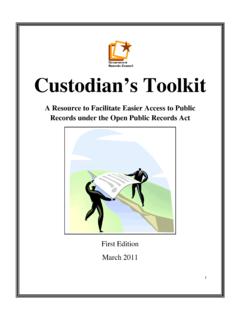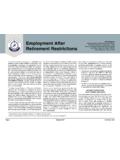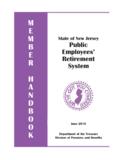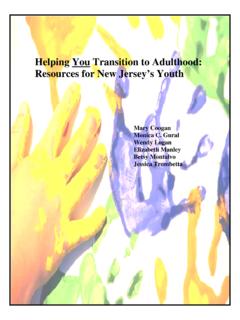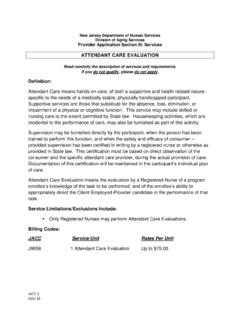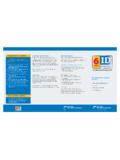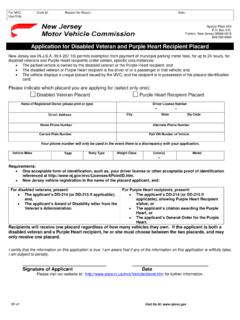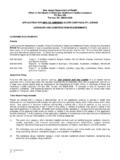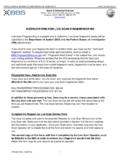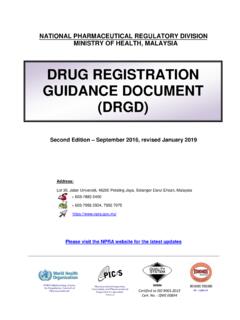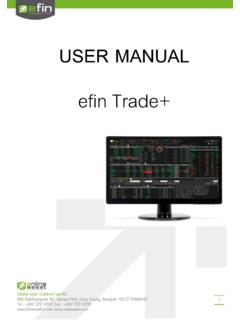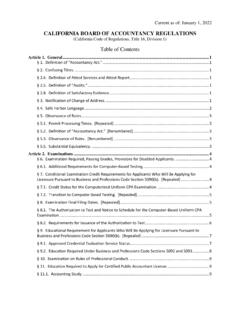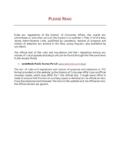Transcription of “When to use the Mechanical Technical Section” revised as of …
1 When to use the Mechanical Technical Section revised as of October 15, 2019. Original article is invalid. Construction Code Communicator State of New Jersey Department of Community Affairs Philip D. Murphy, Governor Lt. Governor Sheila Y. Oliver, Commissioner Volume 31, Number 3 Fall 2019. This edition . 2018 I Codes Adoption, 2018 National Standard Plumbing Code Adoption, 2017 National Electrical Code Adoption, and more! In This Issue Accessible and Type A Dwelling Units 10 IBC/IRC 2018 NJ Editions Errata 3. Attic Protection in Group R Occupancies 3 Laundry Areas 7. Bureau of Housing Inspection: Mailing Update 8 Manufactured (HUD) Homes UCC Role 13. Carnival and Amusement Ride Permitting Update 14 Mass Notification Systems 6. Decommission of PermitsNJ Software 12 New Jersey Code Adoptions Elevator Safety Subcode 7.
2 Educational Occupancy Changes in the 2018 NJ IBC 2 Ordinary Maintenance/Minor Work, Continued 14. Electrical Utility Point of Service 9 Pool Construction and Equipotential Bonding 15. Energy Subcode Compliance as of September 3, 2019. 3 Pressure Reducing Valve (PRV) Replacement 9. Section R324, Solar Energy System Pathways, Roof Access, and Fire Watch During Construction 7 9. Setback Requirements Water Heater Replacements and the Mechanical Technical Section GFCI Receptacle Location for Dishwashers 13 12. Grace Period for Model Codes 2 When to use the Mechanical Technical Section 15. Division of Codes and Standards, Box 802, Trenton, NJ 08625-0802 Page 2 Construction Code Communicator Grace Period for Model Codes As you may be aware, the 2018 I-Codes, along with the 2018 National Standard Plumbing Code (NSPC) and 2017.
3 National Electrical Code (NEC), were adopted on September 3, 2019. With this adoption comes a six-month grace period for the previous model codes. This means starting that from this date, applicants may submit a complete permit application, including all prior approvals, to be reviewed under the code in force immediately preceding the subcode revision. Provided that the application is complete, the construction official and applicable subcode officials should perform the plan review and issue construction permit(s) based on the code in force immediately prior to the operative date of the subcode revision. The last day for application submission under the 2015 I-Codes, 2015 NSPC, and 2014. NEC is March 2, 2020. Therefore, if a complete permit application was submitted on or between the dates of September 3, 2019 and March 2, 2020, the project would be permitted to be reviewed under the old codes (2015/2014).
4 The application should explicitly state which codes were used for the design. In the event the code edition is not explicitly stated, officials should ask what edition was used for the design of the project. For completeness, the application would include items mentioned at NJAC 5 , Construction permits . application, Section (a) is an absolute. However, Section (b) states, In addition [to (a) above], the following information shall be required on any application for a construction permit when such information is available, but not later than the commencement of work. Therefore, items listed in (b), such as the name of a sprinkler contractor to be used, would not be required at this time. Note: Prototype plan releases based on the 2015 I-Codes, etc. remain valid until the end of the grace period.
5 Therefore, March 2, 2020 would be the last day to apply for a permit with the released prototype. Source: Rob Austin Code Assistance/Development Unit (609) 984-7609. Educational Occupancy Changes in the 2018 NJ IBC. An additional threshold was added in Section , Group E, of the 2018 International Building Code (2018/IBC). The new condition now requires the installation of an automatic fire sprinkler system when a school has a fire area that has an occupancy of 300 or greater. In addition, a new section was added in Section , Special doors, of the 2018/IBC. The specific subsection is , Locking Arrangements in Educational Occupancies. This new section has an allowance for locking egress doors from classrooms, offices, and other occupied rooms for enhanced security measures. Group E (K-12) and Group B educational occupancies (example: tutoring centers) can provide additional locking requirements to keep intruders out and still continue to comply with the applicable means of egress requirements.
6 The following conditions must be met: 1. The door must be able to be unlocked from the outside of the room with a key or other approved method;. 2. A key, special knowledge or effort must not be needed to unlock the door from inside the room; and 3. Listed panic hardware, fire door hardware, or door closer devices must not be modified. The final new part of this rule allows a door which complies with this section to be locked remotely and unlocked. Source: Michael Whalen Code Assistance Unit (609) 984-7609. Volume 31 Number 3 Fall 2019 Page 3. IBC/IRC 2018 NJ Editions Errata Let me start out by saying, we are imperfect beings and mistakes happen. As much as we tried to make the NJ. editions of the International Building Code (IBC)/2018 and the International Residential Code (IRC)/2018 perfect, we goofed.
7 I would love to say that the following items will be the only mistakes, but I'm also a realist. So, without further ado: IBC/2018, NJ ed, Section , Group A-2 nightclubs. o At the end of the section text, just before the exception, Section should read Section IBC/2018, NJ ed, Table , Spaces with one exit or exit access doorway. o Footnote references of a and g should be deleted at the 125 within the Group R-3 row. IRC/2018, NJ ed, Table (1), Climatic and Geographic Design Criteria o Under the heading of Frost line depth, 2'8 should be 2'6 for SNJ. If you have purchased a NJ edition, please visit and click on Corrected pages (NJ errata) under both the Building Subcode and One- and Two-Family Dwelling Subcode headings. The displayed pages may be printed to update your NJ edition; the errata will be displayed in RED.
8 Source: Rob Austin, Code Assistance/Development Unit (609) 984-7609. Attic Protection in Group R Occupancies When fire sprinkler systems are installed in Group R-1 through R-4 occupancies per Section , NFPA 13R. sprinkler systems, the attic space needs to comply with new Section , Attics, of the 2018 International Building Code (IBC). This was added into the code by the International Codes Council members to address the hazards associated with large multifamily residential occupancies with common attic spaces. The new thresholds in this section that would require an attic to have additional protection are as follows: First, when the roof assembly is located more than 55 feet above the lowest level of required fire department vehicle access in Type III, Type IV, and Type V construction, additional protection must be provided.
9 The designer could pick from one of the 4 following methods to provide the additional protections; 1. provide an automatic sprinkler system; 2. construct the attic using noncombustible materials; 3. construct the attic using fire-retardant treated wood; or 4. filling the attic with noncombustible insulation. Second, when fuel fired equipment is installed in the attic, at least one sprinkler head needs to be installed above the equipment. Third, when the attic is being used for storage, it must be sprinklered. This will impact all buildings, including pedestal buildings, when the eave of the highest roof exceeds 55 feet above the lowest required fire vehicle access road. All heights are measured adjacent to the building to the eave as follows: 1. of the highest pitched roof; 2. the intersection of the highest roof to the exterior wall; or 3.
10 The top of the highest parapet. These measurements are made from the required fire vehicle access roads necessary for compliance with Section 503, Fire Apparatus Access Roads, of the International Fire Code. Source: Michael Whalen Code Assistance Unit (609) 984-7609. Energy Subcode Compliance as of September 3, 2019. As has been the case for at least 15 years now, the Department has issued an Energy Subcode compliance Bulletin with the adoption of a new model code. Because the 2018 International Energy Conservation Code (IECC) was adopted September 3, 2019, Bulletin 19-2 was issued along with it (see ). The following is an abridged version and some extra information. Per 5 (f)vi, the Uniform Construction Code (UCC) requires applicants to show compliance with the Energy Subcode as part of the permit application process for a newly-constructed building or an addition.
